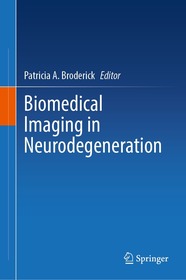
Biomedical Imaging in Neurodegeneration
-
12% KEDVEZMÉNY?
- A kedvezmény csak az 'Értesítés a kedvenc témákról' hírlevelünk címzettjeinek rendeléseire érvényes.
- Kiadói listaár EUR 171.19
-
71 001 Ft (67 620 Ft + 5% áfa)
Az ár azért becsült, mert a rendelés pillanatában nem lehet pontosan tudni, hogy a beérkezéskor milyen lesz a forint árfolyama az adott termék eredeti devizájához képest. Ha a forint romlana, kissé többet, ha javulna, kissé kevesebbet kell majd fizetnie.
- Kedvezmény(ek) 12% (cc. 8 520 Ft off)
- Kedvezményes ár 62 481 Ft (59 506 Ft + 5% áfa)
Iratkozzon fel most és részesüljön kedvezőbb árainkból!
Feliratkozom
71 001 Ft

Beszerezhetőség
Még nem jelent meg, de rendelhető. A megjelenéstől számított néhány héten belül megérkezik.
Why don't you give exact delivery time?
A beszerzés időigényét az eddigi tapasztalatokra alapozva adjuk meg. Azért becsült, mert a terméket külföldről hozzuk be, így a kiadó kiszolgálásának pillanatnyi gyorsaságától is függ. A megadottnál gyorsabb és lassabb szállítás is elképzelhető, de mindent megteszünk, hogy Ön a lehető leghamarabb jusson hozzá a termékhez.
A termék adatai:
- Kiadó Springer Nature Switzerland
- Megjelenés dátuma 2025. november 27.
- Kötetek száma 1 pieces, Book
- ISBN 9783031958779
- Kötéstípus Keménykötés
- Terjedelem311 oldal
- Méret 235x155 mm
- Nyelv angol
- Illusztrációk XIV, 311 p. 81 illus., 55 illus. in color. Illustrations, black & white 700
Kategóriák
Hosszú leírás:
"
This new volume focuses on the bioimaging of Parkinson’s, Alzheimer’s, and the epilepsies, presenting the latest in the technologies that diagnose and treat the person who has the disease, enabling personalized medicine. The book presents chapters on the “know-how” of the technologies, the nanotechnologies and functional nuclear and molecular imaging of neurodegenerative early and late-stage biomarkers. Technology has evolved in conceptual, theoretical and empirical leaps and bounds. A metallopolymer of the tau peptide is imaged online in PD subjects with nanoprobe biosensors, trademarked BRODERICK PROBE® via neuromolecular imaging (NMI), a non-nuclear potentiometry that enables algorithms for walking and hand mobility patterns and hypokinetic dysarthria in PD patients is detected using Conventional Neural Networks (CNN). Magnetic resonance imaging (MRI) and dopamine transporter single-photon emission computed tomography (DAT-SPECT) in degenerative parkinsonism and related disorders differentially diagnose PD from essential tremor, (ET), parkinsonian syndrome, (PS) and dystonia tremor (DT) and atypical parkinsonian syndromes including multiple system atrophy (MSA) and progressive supranuclear palsy (PSP) are also differentiated from Atypical PD. Approaches to imaging both pre- and post-synaptic function highlight molecular nuclear imaging via 18F-DOPA PET/SPECT imaging in PD and intraoperative images of neocortical Tau in the epilepsy patient are recorded with NMI guided by iMRI by Broderick nanoprobes. Subclinical Epileptiform Activity (SAE) of the AD patient is introduced as a likely phenotype for epilepsy in the AD patient whereas a stimulation paradigm, used in the brainstem of diabetic subjects, links to degenerative neuropathy. The profundity of epilepsy disorders such as in status epilepticus (SE) are reported as Increased T2 or fluid-attenuated inversion recovery (FLAIR) in MRI. Childhood tuber and focal cortical dysplasia are shown by high AMT uptake on PET imaging, introducing the PET tracer alpha[11C]-methyl-L-tryptophan (AMT) to intractable epileptogenesis while proton magnetic resonance spectrometry (MRS) delves into the Alzheimer patient to image N-acetyl aspartate for one example. Finally, natural cannabis compounds (CBD), as their biochemistry relate to Aβ peptide via the Wnt/β-catenin and other intriguing signalling pathways, are discussed in-depth. The book is a textbook for those who seek advice about tracer probes and sensor probes for the dementia diseases related to AD. The reader shall find the book, all encompassing and hopefully, it shall embrace all to the vitality of the issue of neurodegeneration in the human and the humanoid.
" TöbbTartalomjegyzék:
Magnetic Resonance Imaging and Magnetic Resonance Spectroscopy in Parkinson’s Disease.- Positron Emission Tomography and Single-Photon Emission Tomography in the Diagnosis of Parkinson’s Disease.- Positron Emission Tomography in Parkinson’s Disease.- [123I]-Altropane SPECT.- Positron Emission Tomography and Embryonic Dopamine Cell Transplantation in Parkinson’s Disease.- Neurotoxicity of the Alzheimer’s Amyloid Peptide.- Functional Imaging and Psychopathological Consequences of Inflammation in Alzheimer’s Dementia.- Neurotoxic Oxidative Metabolite of Serotonin.- Predicting Progression of Alzheimer’s Disease With Magnetic Resonance.- Stages of Brain Functional Failure in Alzheimer’s Disease.- Epilepsy.- Neocortical Epilepsy.- Pediatric Cortical Dysplasia.- Bioimaging L-Tryptophan in Human Hippocampus and Neocortex.- In Vivo Intrinsic Optical Signal Imaging of Neocortical Epilepsy.- Intraoperative Magnetic Resonance Imaging in the Surgical Treatment of Epilepsy.- Periodic Epileptiform Discharges Associated With Increased Cerebral Blood Flow.- Imaging White Matter Signals in Epilepsy Patients.- - Overview of the Leukoencephalopathies.- Pyramidal Tract Involvement in Adult Krabbe’s Disease.- Imaging Leukodystrophies.- Advanced Magnetic Resonance Imaging in Leukodystrophies.- Childhood Mitochondrial Disorders and Other Inborn Errors of Metabolism Presenting With White Matter Disease.- Mitochondrial Disease.
Több




